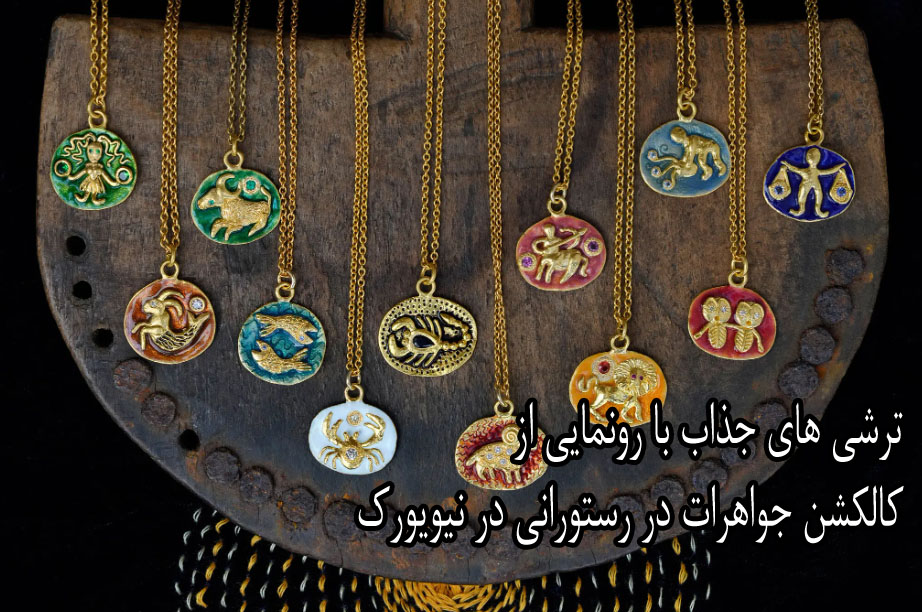
image:bonyadimag.ir
bonyadi magazine
Elvira Golombosi and her partner, Hector Lasso, first started selling their jewelry line, Oraïk, in 2015 at the Las Dalias market in Ibiza. The intimate setting allowed them to have direct connection with their clients, which is still a priority for the couple. “I like to know where all our pieces go,” says Golombosi. The designer, who is originally from Ukraine, first visited Ibiza on holiday in 2013 and felt an immediate connection to its bohemian aesthetic; she and Lasso now live there about half the year. Eventually, through word of mouth, their talismanic pieces — a ring in the shape of a jaguar with diamond eyes or a gold bracelet with two snake heads — became so coveted by the island’s insiders that, as of last year, the couple shifted to selling through studio appointments and scheduled appearances at the Sabina Estates, an exclusive development with villas designed by multiple architects including David Chipperfield. Golombosi, who designs the jewelry, sculpts each shape from soft wax while Lasso makes a cast of it and sets the stones. They have always worked in an organic way, creating pieces that look like they “could be found in an archaeological museum,” says Golombosi. This summer, she had the urge to create a collection of pendants inspired by the zodiac. “The symbols of the zodiac are both ancient and figurative, so I wanted to do my own version of it,” she explains. The result: disks of gold with childlike reliefs that are colored with a centuries-old enamel technique and feature small gemstones. The couple has created a limited series of 50 pendants per symbol, launching this week for pre-order, and by the end of the year they will be available at Love Adorned in New York City. $1,600 each, without chain, oraik.eu
In Haitian Pikliz, Transformation and Tradition
Pikliz is an everyday Haitian condiment made from naturally crisp vegetables like cabbage and onion, plus the specific fruity heat of Scotch bonnet peppers, all pickled through submersion in vinegar and salt. At the restaurant Kann in Portland, Ore., the Haitian American chef Gregory Gourdet touches up his recipe with lime juice and shallots. “Finding that perfect balance of salt and acid and heat really makes the best pikliz,” says Gourdet, who adds that the condiment’s real magic is the transformation of pantry staples into something greater than their disparate parts, and in very little time. (Pikliz only needs a few hours to ripen, though some say it’s better after a few days.) “It’s so humble, but the combination, it’s explosive,” he says. At Honeysuckle Provisions, a cafe and grocer opening in West Philadelphia later this month, chef Cybille St. Aude-Tate, also Haitian American, will serve homemade pikliz at Friday fish dinners and sell jars of it. She’s sourcing the traditional ingredients from neighboring Black-owned farms and featuring allspice as the primary seasoning. “We want to introduce people to the culture first and how it connects to the island, how it connects to migration,” says St. Aude-Tate. In time, she may incorporate okra or green beans, acknowledging that substitutions are common within the diaspora. “You had to make do with what you had,” she says. In Milford, N.H., chef Chris Viaud is serving pikliz in a fried-chicken sandwich at his family’s just-opened traditional Haitian restaurant, Ansanm. In New Orleans, pikliz shows up on a plate of fried tostones at the Pan-Caribbean restaurant Cane & Table. While these chefs largely serve pikliz alongside fritay, or fried foods, in their restaurants, their at-home application is broader: Pikliz goes wherever a dash of vinegared hot sauce or a tangy slaw might go. As St. Aude-Tate says, “In our household, we put pikliz on everything
Furniture Inspired by Fractals and Finnish Folklore
There will be many eye-catching pieces on view at the contemporary design fair PAD, held this week in London’s Mayfair, but one worth lingering on is an extraordinary wooden cabinet embedded with a tapestry designed by the Finnish multidisciplinary artist Kustaa Saksi. Originally a graphic designer, about a decade ago Saksi went to the Textiel Museum in Tilburg, the Netherlands, which also houses a textile lab and workshop, with the idea of turning one of his visual ideas into a tapestry. “It opened up a whole new world for me,” he says. Saksi has since been commissioned by fashion brands such as Hermès, to create immersive window displays, and Marimekko, to create fabric collections. More recently he has incorporated his textiles into furniture. He worked with the renowned Finnish cabinetmaker Nikari to create a wardrobe made from the wood of an apple tree with textile work woven of Japanese paper yarn then framed in brass. The result is something out of Narnia; the imagery that Saksi uses is inspired by both fractals and Finnish folklore. “These archetypal — often pagan-era — characters are still very much ingrained in Finnish culture,” Saksi says. The piece showing at PAD features abstract trees and rock formations woven with eggplant purple, brown, yellow and green threads, a reference to the hiisi, which in pagan times referred to a sacred grove in the forest and then later was redefined as a demonic trickster. “It was the church that probably changed the meaning,” says Saksi. “I’m interested in those ancient mythic figures that have been maligned over time because I think this is a time that we might need them.” On view from Oct. 10-16, kustaasaksi.com











